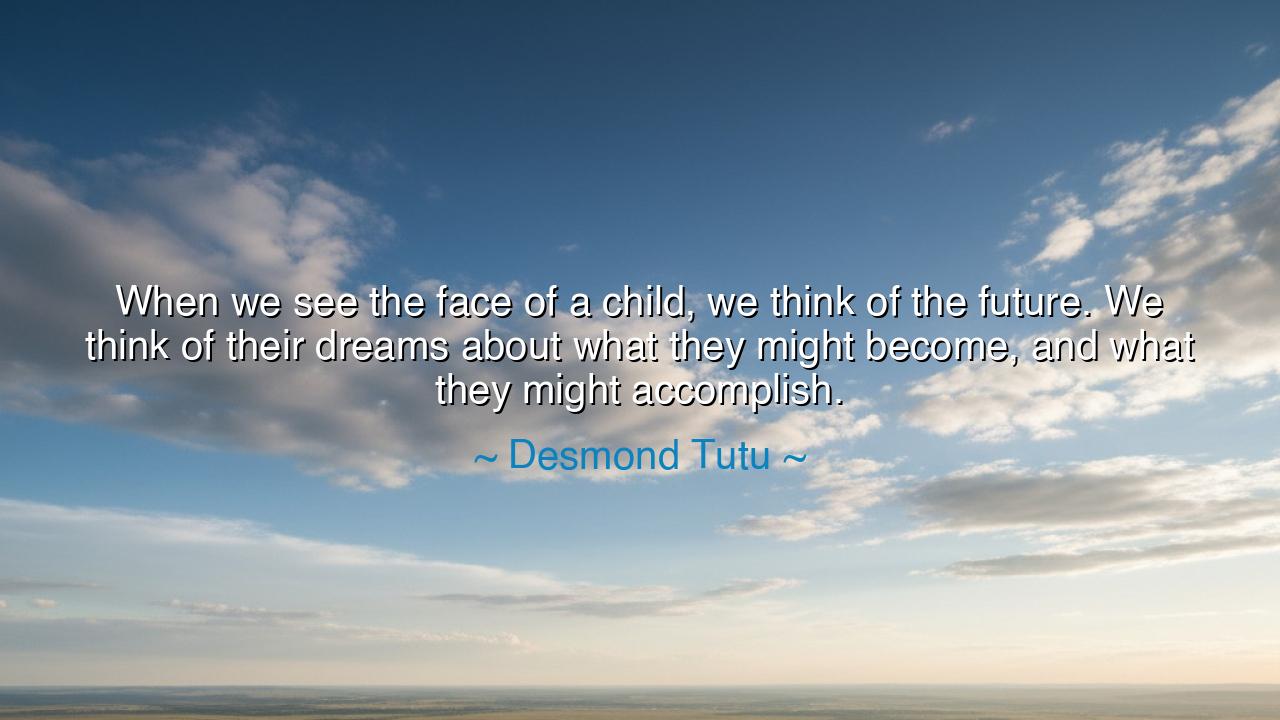
When we see the face of a child, we think of the future. We think
When we see the face of a child, we think of the future. We think of their dreams about what they might become, and what they might accomplish.






"When we see the face of a child, we think of the future. We think of their dreams about what they might become, and what they might accomplish." With these words, Desmond Tutu captures a powerful truth that resonates deeply in the human spirit. The face of a child, full of potential and innocence, represents all the possibilities and dreams yet to be realized. In every child, we see the promise of the future—a future that we, as a society, are tasked with shaping and nurturing. Children are the seeds of what is to come, and how we tend to them determines the harvest of tomorrow. This simple yet profound observation holds the weight of generations, reminding us that the future is not some distant, abstract concept, but something that begins with the young, the hopeful, the dreamers of today.
The ancients, too, understood the importance of the young and the potential they carried. Socrates believed that the future of society lay in the minds and hearts of the young, and he dedicated his life to teaching and guiding the youth of Athens. The great philosopher spoke of the need to nurture the soul and to guide young minds toward virtue and wisdom. For the ancients, the future was not something that could be predicted by looking into the distance; it was something that was being shaped with every word spoken and lesson taught. Just as Tutu sees the face of a child as a reflection of the future, so too did the ancients understand that every child carried within them the potential for greatness, for good or for evil.
In the sacred traditions of the Native American cultures, children were revered as the carriers of the tribe's legacy. The Iroquois, for example, held a deep belief that the decisions made today would impact the seven generations to come. They understood that the future was not simply the inheritance of material wealth or power, but the continuation of wisdom, values, and traditions. In this way, the face of a child symbolized not just the hope of individual dreams, but the well-being of the whole tribe. To harm the child was to harm the future itself, for in them resided the future generations who would uphold the values of the community.
Consider the example of Nelson Mandela, whose life was marked by his vision for the future of his people. Mandela spent years in prison, but throughout that time, his thoughts were always focused on the generations to come—on the children of South Africa and their future. He did not live for the fleeting moments of his own lifetime; he lived for the freedom and dignity that he hoped future generations would enjoy. Upon his release, Mandela's thoughts were not on revenge or retribution, but on healing a nation and building a future where children could grow up without the chains of apartheid. His vision for the future was shaped by his belief that the dreams of the young, their hopes, were the most important part of his legacy.
Tutu's words also invite us to consider the role of dreams in shaping the future. Children are not just the future in the sense of mere survival—they are the creators of the future. Their dreams, their ability to imagine new possibilities, are what will drive the innovations, the movements, and the progress of tomorrow. Consider the young minds that have given the world transformative ideas: Marie Curie, whose discoveries in science were rooted in the curiosity of a child, or Mahatma Gandhi, whose dreams of freedom for his people began with the hope of a better world. The dreams of children, nurtured and protected, are the foundation of society's growth.
The lesson here is one of great importance: the future is not something we passively wait for—it is something we actively create with the young people of today. To see a child’s face is to see the embodiment of hope and potential. We must recognize the responsibility that comes with this gift. As parents, educators, and leaders, we must do everything in our power to help children realize their dreams, to give them the tools to succeed, to encourage their creativity, and to foster their compassion. We must also teach them the value of the past, the wisdom that has been passed down through generations, so they can build a future that honors both their dreams and the lessons of history.
Let us not take lightly the power of a child’s face—for in it lies the key to the future. Let us strive to be the mentors, the guides, and the stewards who help children grow into the people they are meant to be, shaping a world that is full of compassion, wisdom, and progress. In doing so, we will ensure that the future they inherit is one they can be proud of—one that reflects their highest potential and fulfills the dreams we help them to dream.






AAdministratorAdministrator
Welcome, honored guests. Please leave a comment, we will respond soon